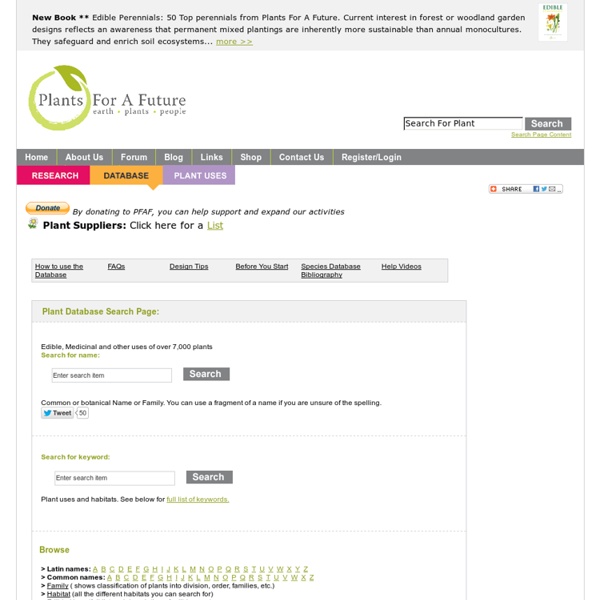Database Search
To the best of our knowledge all the information contained herein is accurate and true. However we cannot guarantee that everyone will react positively to all edible plants or other plant uses. It is commonly known that many people suffer allergic reactions to conventional foods and products. Many people are allergic to strawberries and will come out in a rash if they eat them.Some people develop a rash if they touch the stems of parsnips. We strongly recommend the following preventative precautions when trying anything new: Make sure you have identified the plant correctlyTry a small taste of anything new in your diet.
Apprendre l'allemand - cours d'allemand gratuits
Qu'est-ce qu'un volcan ?
Les couleurs de l'orchestre Retrouve toutes les vidéos de la série "Les couleurs de l'orchestre" avec des jeux, des animations et des explications complémentaires sur chacun des instruments et chœurs de l'Opéra. Partenariat Théâtre Nouvelle Génération de Lyon / Cap Canal En tant que Centre Dramatique National, le Théâtre Nouvelle Génération est un lieu dédié en priorité à la création théâtrale. Dirigé depuis 2 004 par Nino D’Introna, il fait partie des trente trois institutions culturelles françaises à bénéficier de ce label d’excellence, attribué par le Ministère de la Culture au regard de la qualité artistique du projet. Animés par les mêmes valeurs, le TNG et Cap Canal ont naturellement développé un partenariat avec par le biais d’émissions, comme la série « Les p’tits lez’arts », « Fais ton cinéma », et de coproductions. Depuis 2006, Cap Canal en coproduction avec Camp de Base, réalise une collection DVD des créations du TNG.
GoogleMaps vers GPS
Accueil > Balades > Utilise la puissance de Google Maps pour créer tes itinéraires et visionne tout cela dans Clic0 pour avoir des informations intéressantes avant de partir en balade. En final, si tout est OK, injecte ta balade dans ton GPS et zouuuu !!! Cela en 4 points : 1. Pour le départ de la balade, clic droit pour commencer un « itinéraire à partir de ce lieu » Pour l’arrivée, clic droit pour définir un « Itinéraire vers ce lieu » 2. Attention : j’utilise Firefox 24.0 et il est nécessaire de modifier la configuration pour que GMapsToGpx fonctionne : ouvrir Firefox saisir dans la barre d’adresse : about:config appuyer sur la touche CTRL et en même temps sur la touche F pour rechercher : security.mixed_content.block_active_content double-cliquer pour changer la valeur de true en : false A l’aide du Bloc-notes de Windows : on met le code XML qui est proposé par GMapToGPX on enregistre en choisissant un codage UTF-8 l’extension du fichier est « gpx » (essai.gpx par exemple) dans : <? 3. 4.
clic0
OruxMaps en balade L’application OruxMaps semble avoir été faite pour ceux qui se baladent. Qu’à cela ne tienne, ici, sur Clic0, on aime ça ... Lire la suite... New ClicGPX, la perle ! >> Lien direct << - Clic0 continue le développement de ClicGPX. ScrutGPX >> Lien direct << - Vous souhaitez afficher et analyser une trace GPS sur une carte IGN. La saga des Waypoints Les points (waypoints) contenus dans les cartes Garmin™ de rando sont nombreux. Florilège de TYPs On peut changer l’affichage simplifié des cartes Garmin™. A pied, en VTT, à ski, ..., mais avec un GPS, retrouvailles avant ou après les sorties. Petits bijoux pour un repérage géographique sur notre planète terre ... Ce site est nouvellement créé et évolue techniquement et visuellement ... La TYPattitude, c’est quoi ? C’est rechercher à afficher des cartes (sur votre GPS Garmin™, sur votre ordinateur ou sur votre smartphone) avec plus de réalisme, d’efficacité et d’esthétisme.
Paperboyz
La référence de l'actualité scientifique
Batch Géocodeur - géocodage google map en français gratuit
Related:
Related:




PFAF: Base de données sur la flore; avec différentes méthodes de recherches (EN) by fetelevousmeme Sep 24